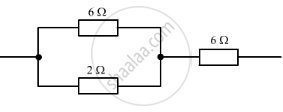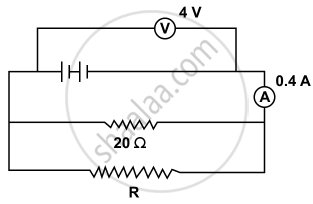Advertisements
Advertisements
Question
The figure given below shows three resistors?

Their combined resistance is:
(a) `1 5/7`Ω
(b) `14` Ω
(c) `6 2/3` Ω
(d) `7 1/2` Ω
Solution
(d) `7 1/2`Ω
The resistors of 6and 2 are connected in parallel
∴ `1/R=1/R_1+1/R_2`
Here,
`R_1=6`Ω
`R_2=2` Ω
`1/R=1/6+1/2`
`1/R=4/6`
`R=6/4`
This arrangement is further connected in series with the 6 resistor
∴Net resistance` =6/4+6=7 1/2` Ω
APPEARS IN
RELATED QUESTIONS
Which of the following arrangement, A or B, has the lower combined resistance?

A wire that has resistance R is cut into two equal pieces. The two parts are joined in parallel. What is the resistance of the combination?
Four resistors each of resistance 2Ω are connected in parallel. What is the effective resistance?
In the following figure calculate:
- the total resistance of the circuit
- the value of R, and
- the current flowing in R.

A particular resistance wire has a resistance of 3 ohm per meter. Find the potential difference of the battery which gives a current of 2 A in each of the 1.5 m length when connected in the parallel to the battery (assume that resistance of the battery is negligible).
State the S.I. unit of electrical resistance and define it.
A given wire is stretched to double its length. How will its resistance change?
Three resistors of 6Ω, 4Ω and 4Ω are connected together so that the total resistance is 8Ω. Draw a diagram to show this arrangement and give reason to justify your answer.
Two V-I graphs A and B for series and parallel combinations of two resistors are as shown. Giving reason state which graph shows (a) series, (b) parallel combination of the resistors.

You have three resistors of values 2 Ω, 3 Ω, and 5 Ω. How will you join them so that the total resistance is less than 1 Ω? Draw a diagram and find the total resistance.
